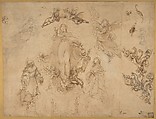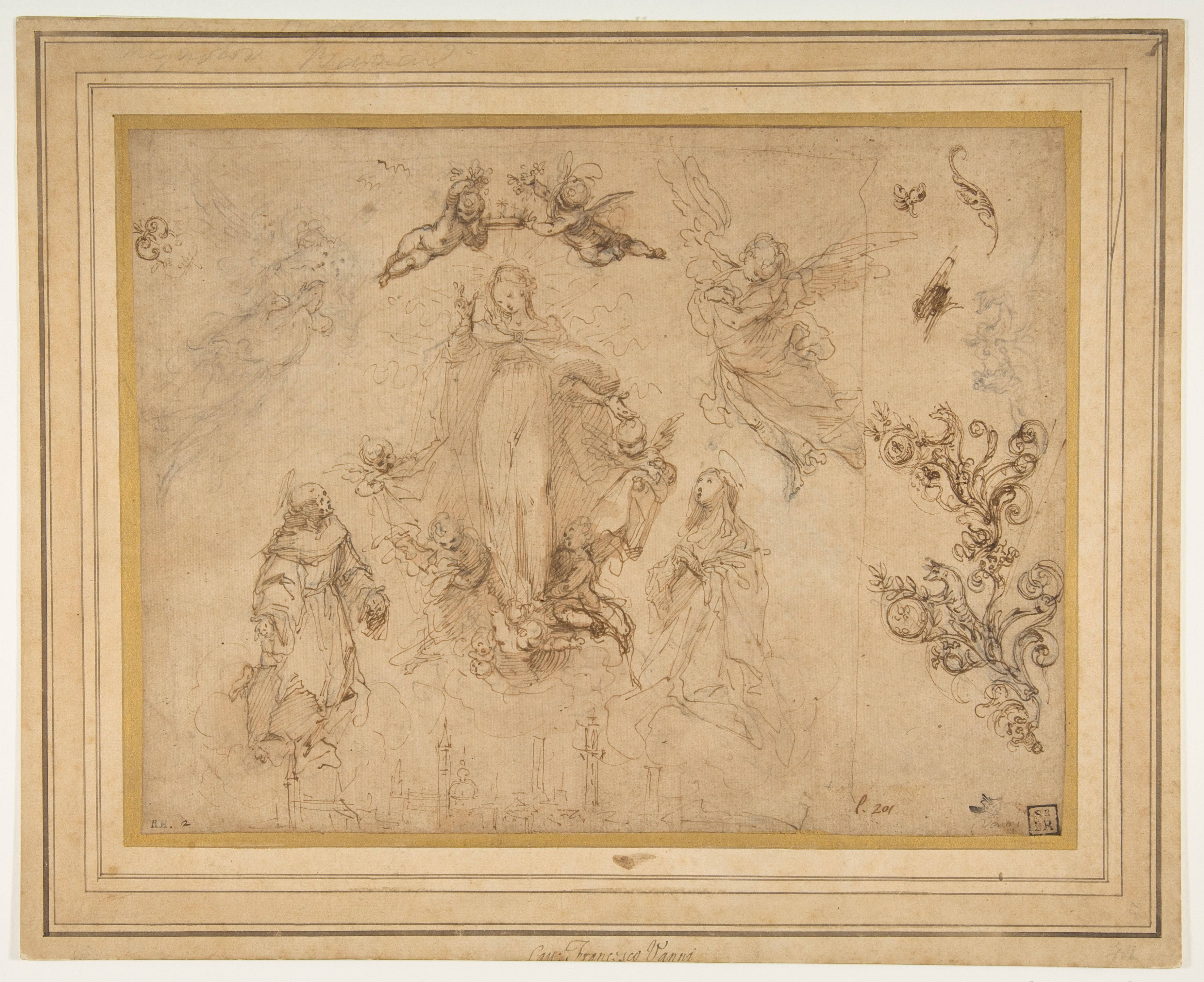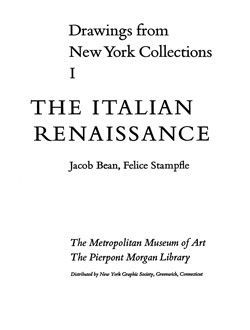The Virgin Protectress of the City of Siena
Francesco Vanni Italian
Not on view
Vanni studied painting briefly in Rome, but, before his twentieth birthday, he was back home in Siena, where he pursued a long career as a painter of altarpieces and decorations for public buildings. In this brisk and luminous sketch, the Virgin appears in glory, her right hand raised in benediction, while Saint Bernardino and Saint Catherine of Siena intercede for their fellow citizens. Toward the lower border of the composition appears a view of the skyline of Siena, easily identified by the silhouettes of the Torre del Mangia, the dome and bell tower of the Cathedral.
The right border of the nearly square composition is indicated by a vertical framing line, at the right of which are sketches for heraldic devices. A squared study in pen and brown ink with wash for this same composition was in the collection of Sir John Pope Hennessy, New York (Courtauld photograph B66/229). It has been plausibly suggested that both drawings were studies for a Sienese Biccherna panel. Such panels were originally used as covers for the financial records of the Republic of Siena, but were later conceived of as independent works of art. They commemorated in pious and patriotic imagery the terms of office of municipal comptrollers. The subject and even the format of the composition would be eminently suitable for such a purpose, and the heraldic emblems studied at the right in the Museum's drawing could easily have figured in the arms of an incumbent officer on a Biccherna panel. Vanni did in fact paint at least one Biccherna panel; it commemorates an administration of the Biccherna that ran from July 1601 to June 1604 and includes a representation of the Madonna of Provenzano venerated by Saint Bernardino and Saint Catherine of Siena (illustrated and discussed in E. Carli, Le tavolette di Biccherna, Florence, 1950, no. 99, pl. 110).
With regard to the provenance, this drawing was in the collection of the famous eighteenth-century collector and connoisseur Sebastiano Resta, and it also exhibits the "Resta-Somers" mark, a lower case letter followed by a period and a number, which establishes its presence in Great Britain since the early 18th century. As has recently been demonstrated, the drawings bearing the "Resta-Somers" mark seem to have all also passed through the collections of Monsignor Giovanni Mattei Marchetti, Bishop of Arezzo, reigned 1691-1704, and were the subject of dispute between Resta and the bishop, and then on the bishop's death in 1704 his heir Cavaliere Marchetti. The Marchetti provenance is nearly a certainty, as pointed out by Genevieve Warwick, despite the disparities of evidence, noted by earlier scholars following A.E. Popham's pioneering article on Resta in 1936, between the contents of Resta's collection as owned by the Marchetti heir that are listed in the letter of John Talman of March 2, 1710, as agent in Italy to Lord John Somers, and the manuscript transcription of this Resta-Somers collection (Lansdowne Ms. 802, British Library, London) compiled by the Jonathan Richardsons, father and son, as they disassembled the Resta albums. (Compare A.E. Popham, "Sebastiano Resta and his Collections," Old Master Drawings, 10 (1936), pp. 1-19; G. Warwick, "The Formation and Early Provenance of Padre Sebastiano Resta's Drawing Collection," Master Drawings, 34 (1996), pp. 239-78; G. Warwick, "Gift Exchange and Art Collecting: Padre Sebastiano Resta's Drawing Albums," The Art Bulletin, 89 (1997), pp. 630-46; G. Warwick, The Arts of Collecting: Padre Sebastiano Resta and the Market for Drawings in Early Modern Europe, Cambridge and New York, 2000; G. Warwick, "Connoisseurship and the Collection of Drawings in Italy c. 1700: the Case of Padre Sebastiano Resta," Collecting Prints and Drawings in Europe c. 1500-1750, ed. by C. Baker, C. Elam, and G. Warwick, London, 2003, pp. 141-53.)
In Richardson's copy of Resta's manuscript notes on the mounts of his drawings (Lansdowne 802, British Library, London), the present drawing is described as it is on the mount: " 201 (Cav: Fro: Vanni. Va in Stampo [sic - presumably this should read "Stampa" nei Santi di Siena). 202" (as transcribed in letter from John Gere, British Museum, March 1962, Archive of Department of Drawings and Prints). When this drawing passed into Reynolds's ownership, it may have been sold at his sale, at Harry Phillips, London, on March 21, 1798, it may have been part of lot 1459, p. 67: "1459 3, Maturino, F. Vanni, Polidoro."
The Museum's drawing is described in the British Library Landowne 802 Manuscript, Lib.L., fol. 231 (crossed out and corrected to fol. 227) recto: " 201/202} Cav: Fr°: Vanni. va in stampe nei Santi di Siena." [ possibly "stampe" not "stampo" as Gere thought, Richardson's "e" and "o" are very similar and "201" and "202" were together and this would explain the plural "stampe" of the works].
Carmen C. Bambach, July 2004
Due to rights restrictions, this image cannot be enlarged, viewed at full screen, or downloaded.
This artwork is meant to be viewed from right to left. Scroll left to view more.









